Thamesmead Research Trip March 25th- 29th 2019
It feels strange to be writing a blog about Thamesmead, playing catch up whilst making a sculpture here in Venice with the local population. The project is racing along and time is flying.
The passing of time was to the fore in my impressions of Thamesmead too. I used to pass along its hinterland on my way to Charing Cross on the train from Gravesend for over ten years. Erith, Belvedere, Abbey Wood, Woolwich and Greenwich, but I never once visited, until this opportunity arose for me to work with Bow Arts at the Lakeside Centre and on Giudecca in Venice; both communities that made their homes on the marshes.
Threats from the sea have ever been in the background in Venice, where the ground floors of most homes have been surrendered to the waters. From the onset, Thamesmead was to be inhabited from the first floor upwards with its patterns of high level walkways.
The Venetians arrived with their homes on stilts some 1500 years ago, whilst the first residents of Thamesmead have barely been there a generation. I watched a public information film from 1970, showing Thamesmead’s own stilts of reinforced concrete being hydraulically driven to a depth of 25 feet, as the foundation for this new development. Southmere Lake was being dug and Binsey Walk and Coralline Walk were rapidly erected from thin prefabricated sections, just north from Abbey Wood Station.
Even as the first tenants were moving into their new Utopian estate, Stanley Kubrick was filming ‘A Clockwork Orange’ there; a man who’s dystopian vision now seems prophetic of inherent failings of Thamesmead’s planning, economics and the politics over time. I think of him every time I seen an orange object locally.

And now time like the river sweeps on and the 1970s modernistic vision is a being torn down in front of me. Blue hoardings surround Binsey Walk and the interiors completely stripped out by guys sealed up in white coveralls as they deal with problematic building materials of yesteryear. Probably the asbestos no one mentioned in the promotional films.
Nor did modernist aesthetics ever seem to match the aspirations of many tenants nor the reality of life there. Binsey Walk has a number of Georgian style leaded windows replacing or fixed over the simpler geometry of the original windows. The partitions between apartments are frequently topped with revolving spikes more reminiscent of a prison than a home.
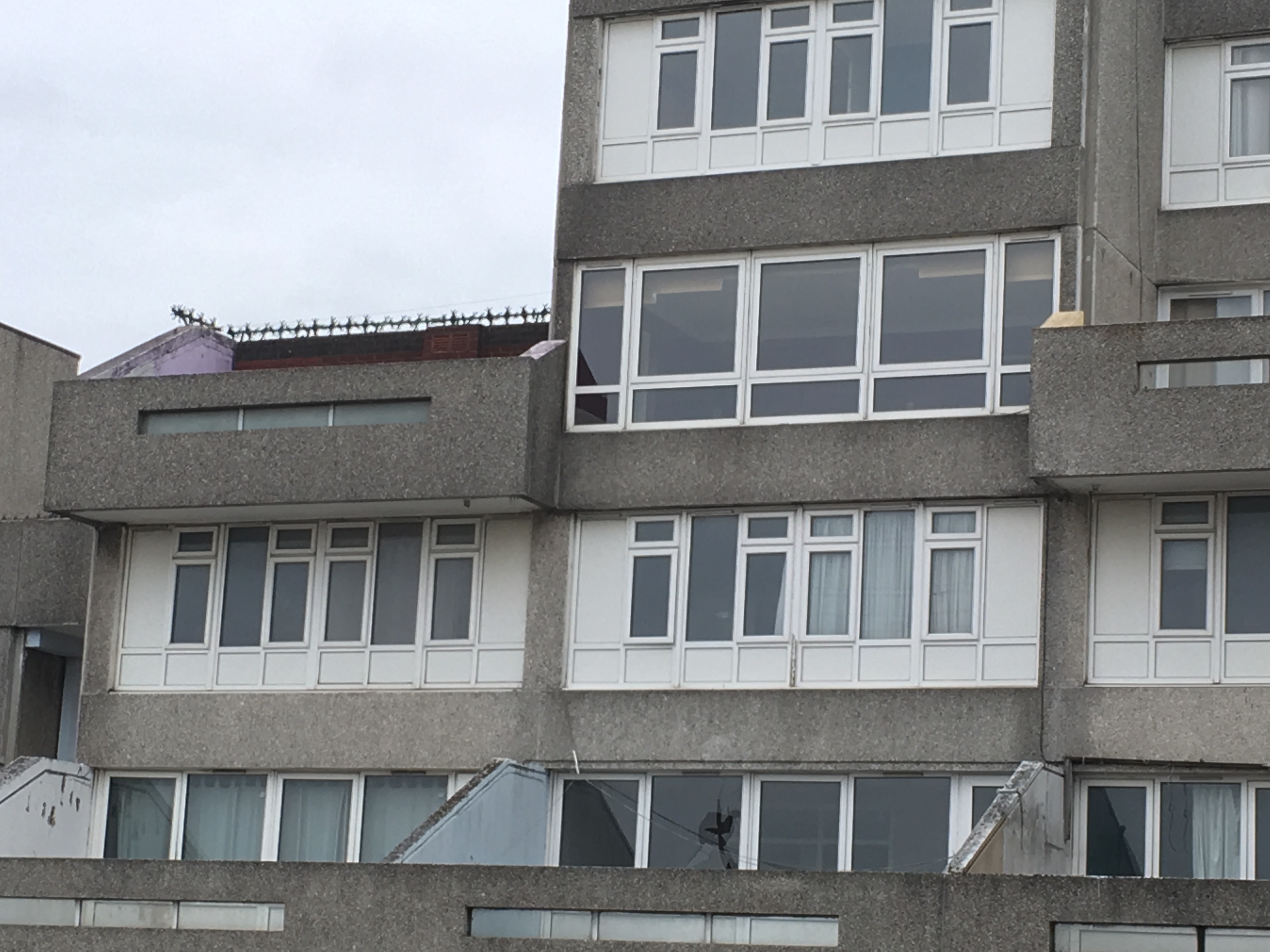
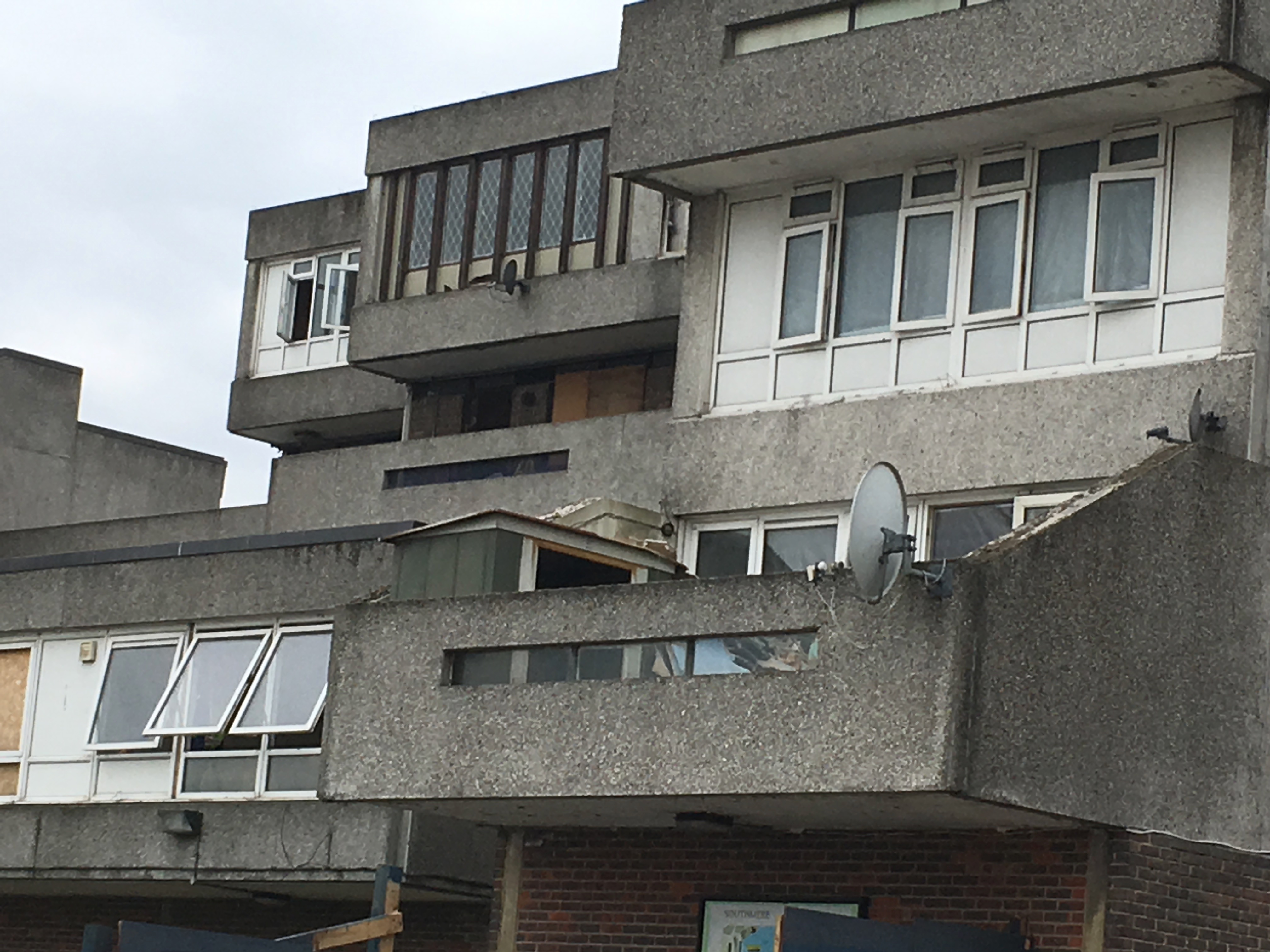
How many promises were kept to the people who pioneered living here? Already in the film I mention above, the tenants’ committee was asking questions with no satisfactory answers from those in power. ‘Why were the windows only cleaned for the visit of the VIPs?’ pleaded one person. Another was shocked that scaffolding, posing a threat to his home from burglars, had not been removed. He was told he should have insurance cover against that sort of thing. All this when the first tenants were still just moving in.
And now the new development is creating another whirlwind of construction as Peabody arrive with their new sustainable plans and deeper community infrastructure and the Eggman is due to deliver the Exbury Egg for twelve months on Southmere Lake.
THAMESMEAD Monday March 25th2019
Michael Smythe from Bow Arts met me off the train at Abbey Wood when I arrived at 10am. We walked via the nearby Sainsbury superstore where Jan and Sheena were shopping for cleaning materials for the flat I’d live in at the Lakeside Centre. It was not quite ready – a mass of IKEA flat packs were waiting to be turned into a three dimensional home – the card and plastic could have made quite a home too. The Lakeside Centre, in the process of refurbishment by Peabody, is still a gated building site and it was an unfamiliar experience to reside there.
Andy was the site manager by winter, and by summer an itinerant festival man doing sound stages at Glastonbury etc. He had followed the Egg and was sensitive to the idea of so called alternative living and diurnal rhythm – “It’s no hippy fringe thing. There’s nothing normal about driving to work in January at six am in total darkness. It’s about control. Being made to fit in to the system I guess. Creating conformity and imposing order – even onto the timetable of a length of day”.
And so I was set to live in a compound within a twelve foot high boundary fence.
Michael took me around the site here to see the almost complete studios for theatre arts, architecture, crafts and visual arts – “its really exciting everyone starts to feed off each other”. There will be a largely organic café, using food sourced within the M25, as well as a local allotment, with an intent to provide quality vegetarian food at a low price point. A nursery for 50 young children managed by the YMCA is due to open on April 24thwith a private open air play area that will be a huge benefit to the high percentage of working mums living in The Moorings (part of Thamesmead to the north west). So the scheme brings together three local charities to help build a unique social ecology based on integration, wellness and culture in daily life – All close to this Eggman’s heart.
The roof has a small field of solar panels. Andy had told me that the site electrician worked out that last week they could have more than met the needs of the fully operational commercial kitchen. Such good news when compared to the relative failure of the Exbury Egg to generate even minimal power from its own solar panels outside of the long days of high summer. There are plans for an allotment to provide vegetarian food at a low price point and healthy takeaway.
Last but not least I was introduced to the quietly spoken Karma, one of the former ghurka security guards, from the local Nepalese community, but there was so much noise on site I could barely hear and his story would have to wait. On a short walk north-east, I was surprised by a flock of parakeets scooting by at treetop height; New residents also?
THAMESMEAD Tuesday March 26th 2019
8am
I finally managed a conversation just now with Karma the Ghurka watchman, who told me there has been little trouble here. After retiring from the army, he had 13 months in Africa as a security guard, where they saw thieves dealt with differently – “ steal once ok, the village headman forgives you. Steal twice the villagers gather round the offender, douse him in petrol and burn him. I saw this.” I had just observed two local men lighting a bonfire up against the site fence on the east side of the building.
Aircraft on the way to City Airport every ten minutes were were so loud I began to lip read to maintain the flow of conversation.
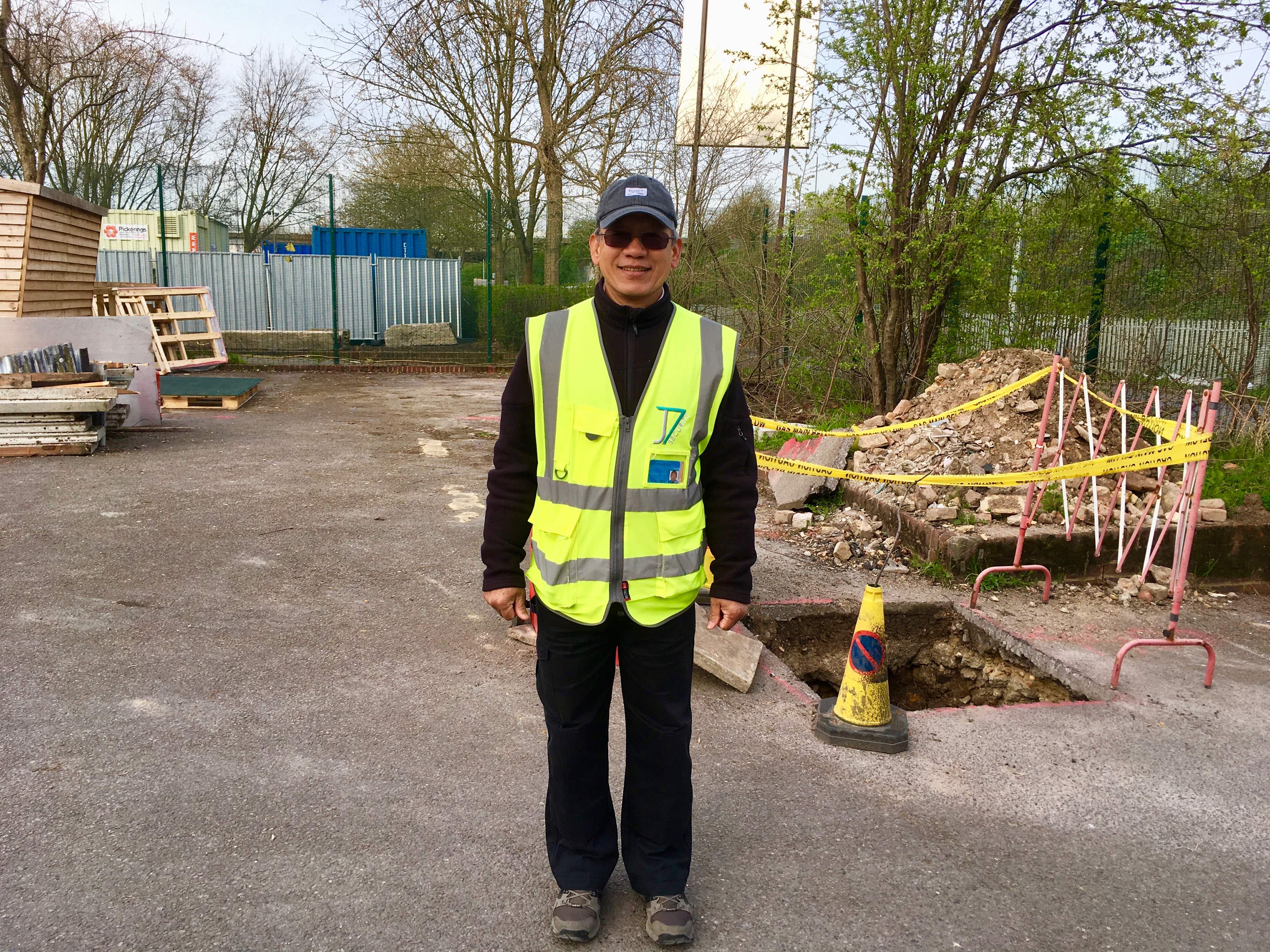
The Thames Path is the northern perimeter of Thamesmead, along five kilometers of the river Thames. Every 100 paces, signs mark a different zone – the Greenwich-Bexley border for example is at Zone 153.
The tide being out in 153, afforded a good look at a potential arena for a performance with the river. A concrete ramp sloping down to the riverbed is around 70 metres long and six wide, terminating in a syrupy slime of soaking London Clay. The tide had left the trace of its passing in successive waves of detritus; a distinct line of bladder wrack, then higher, waves of plastic, small bits of wood, a football and other flotsam taking temporary refuge there until the next six metres of high water.
Fastening a cotton voile across the whole area, I could capture one moment in the river’s story. There are steps opposite from where the event might be filmed and even a viewing platform for an audience to watch the canvas slowly emerge from the receding sea. It’s always been exciting to discover what Neptune has offered up on different rivers at various times. Today, a beautiful ready-made and largely plastic egg. A core of seaweed, surrounded by yellow strands of polypropylene rope, that on its journey along the river has bound in some silver and blue ribband like a gift wrap, with twigs, a broken plastic cup, small white feathers and the remains of a black elasticated thong. In the bright morning sun, it had its own monstrous glamour.
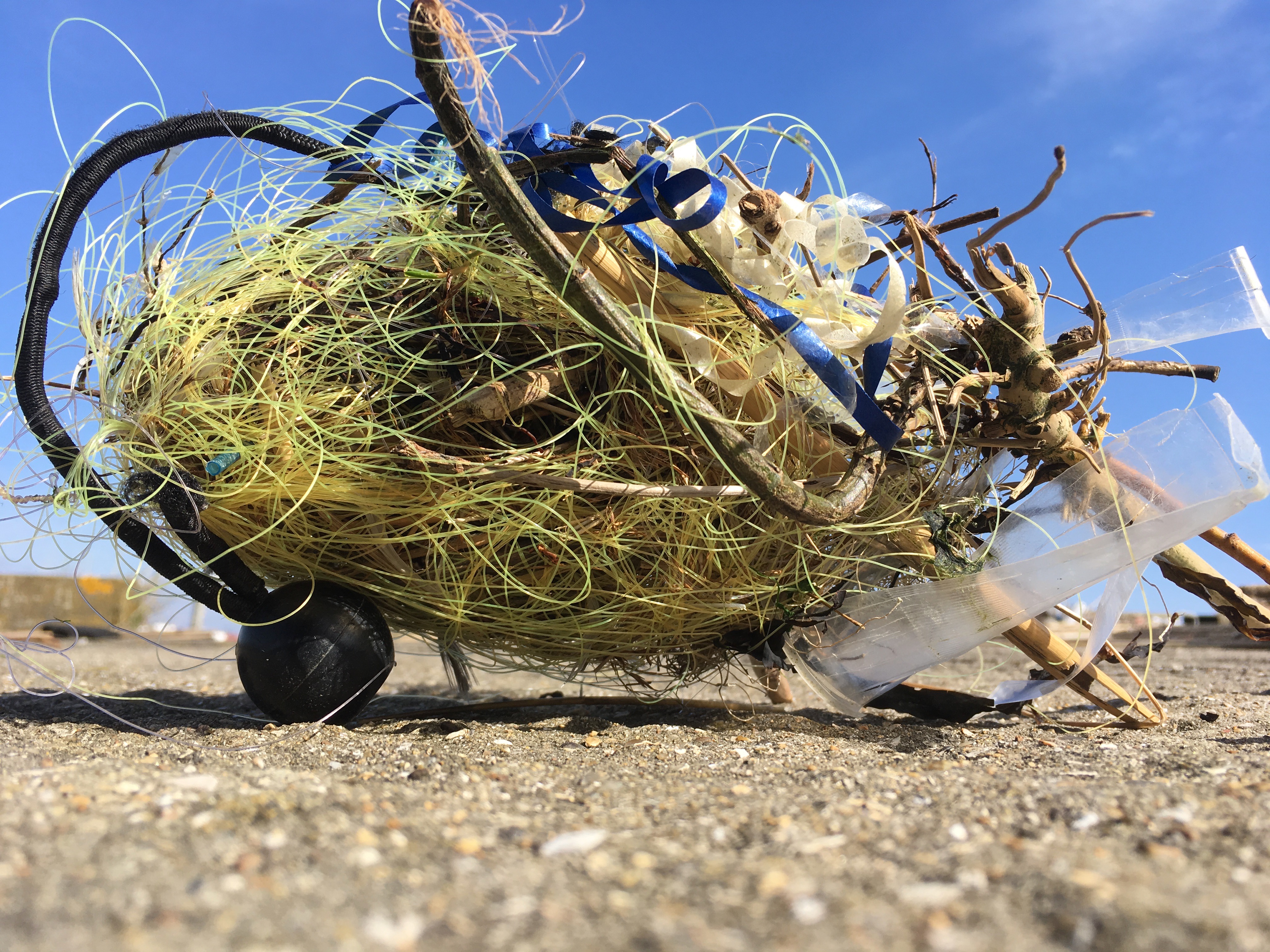
With the Thames Egg tucked away in my rucksack, I set off to discover Thamesmead shopping centre with the aim of tea at the Diana Cafe and a walk around the Thamesmere Lake, which borders the carpark and shops. A sign however declared it unsafe and the path I followed behind Morrisons simply terminated in a tangle of brambles. Retracing my steps I then disturbed a guy in this relative solitude, busy ‘watering the weeds’. The coots were thriving though, and as elsewhere busy making their nests in the shallows amid benign neglect.
The A2041 overpasses a shallow canal aqueduct, that itself raises the water level just 30cm above the footpaths on either side, to subtle and beautiful effect- though a local lady on her way home from the shops tells me it floods frequently. I spent some time watching restful patterns of reflected water appear to dissolve the solid concrete sections of the overpass.
Some sense of the previous military history of the land was suggested by ‘Tump 53’, but arriving out of season, I was frustrated by the surrounding iron fence and locked gate. This former munitions storage site (one of many taking advantage of the complete isolation of this landscape, before development in the 1970s.) is now a nature reserve managed by the London Wildlife Trust with its entrance on Water Lily Walk.
The playground shrieks and squawks of young children at playtime followed me down the path. Michael Smythe had already told me that this part of London has the highest percentage of young families in the country. There are a lot of primary schools.
The afternoon was reserved for a conversation with Petra Cox at Crossness Pumping Station, where we spent a happy afternoon sharing ideas about the whole organic process of managing human waste in cities. How Bazalgette employed natural force of gravity to carry the waste eastward along a shallowly inclined pipe and then used the gravitation effect of the tide to carry it away – with a nudge from the huge steam water lifting engines at his erstwhile temple to waste.
Victorian reverence for human achievement in all walks of life is expressed in a structure, with no expense spared inside or out. The old, church-like main entrance, now hidden behind a later extension, could have graced York Minster. The beauty is also in the detail. Classic cast iron columns inside are not topped with acanthus leaves, but with those of the fig – with individually cast fruits hanging from each column. These decorative representations of natural organic laxatives celebrate the function of the building. The flooring mesh, as Petra also pointed out, is in the form of ripples in water.
It’s a salutary thing to remember that no city or town can survive long without sanitation and how close we all are to the cholera and other water borne disease that the world has never quite shaken off. In Thamesmead, there is an almost daily reminder from the pungent odours of the working sewage treatment plant at the termination of Bazalgette Way – a background smell, like the background noise of the aircraft that defines the particularity of place. Local people seem not to notice. Perhaps ears and nose tune it all out after a while?
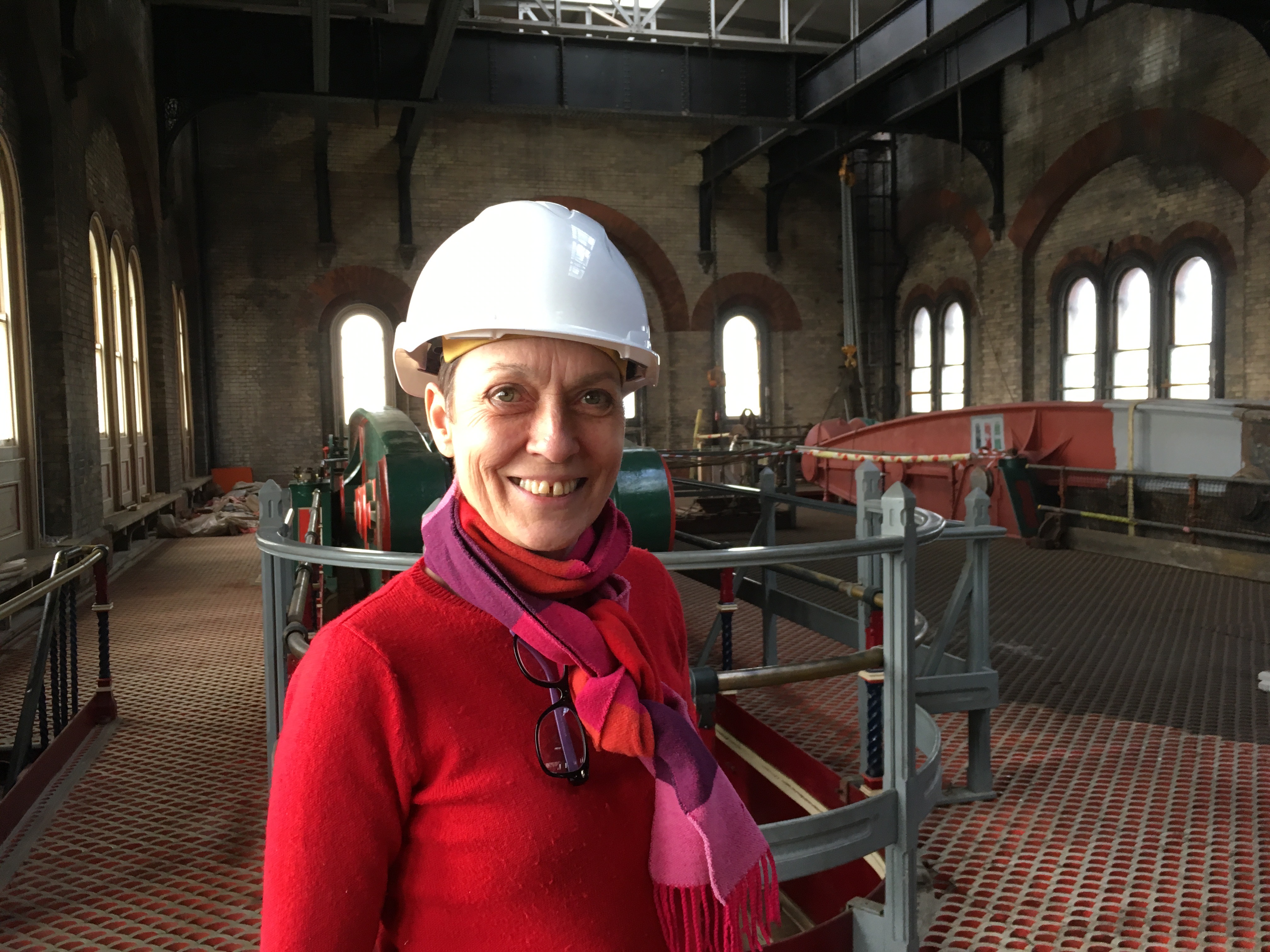
THAMESMEAD Wednesday March 27th 2019
Except for a shower at the nearby Link Centre earlier (the apartment at Lakeside had no hot water yet), shopping at Sainsbury and lunch at the Birchwood Pub, Wednesday has been a day of on-site meetings.
Sophie Hill, her intern Leila and I had gone to the pub on Grovebury Road for a working lunch. A chummy mélange of tudor style beams, toby jugs, and 1970s windows, it felt like a real asset to the area.
The special ham on the bone with chips, was never going to attract the vegetarians along from the Lakeside Centre café, but it was all very welcoming; except for the landlord taking a huge hammer drill to the fireplace in the middle of our meal – a little microcosm of the greater noise of redevelopment around Lakeside just to make us feel more at home.
This morning’s meeting was to determine whether Terry Peach (my haulier) would be able to get sufficiently lakeside to lift the Exbury Egg onto the water. All will be fine if the road takes the truck’s weight, and we hope to get the answer to this from Lisa Drew (Peabody). But, how might she be moored there?
Dani Tagen, Bhajan Hunjan and Joseph Grifiths who are artists interested in working with the Egg when it does arrive, had come to discuss the project in the afternoon and share ideas. All three Iive in the original 1970s tower blocks opposite and I now have an invite to visit when I return. Peabody own and are refurbishing these buildings (at huge cost), only to schedule them for demolition in 18 months time. It is perhaps a legacy of the terrible Grenfell fire. The only three original tower blocks set to remain are those bordering Southmere Lake and facing the Lakeside Centre that were so prominent a beginning to the original planners’ dream.
There are seven kilometers of canals here, connecting seven lakes that were built to manage the drainage of the former marsh landscape and provide the visual amenity of waterside living. Thames 21, the London Based environmental volunteers who do regular waterside clean ups assert that 90% of the waste on the canals is plastic. It would be of interest to work with them to gather the waste plastic into an artwork as I am currently doing in Venice.
THAMESMEAD Thursday March 28th 2019
Up early to photograph the Polish man feeding the large group of resident swans on the Lake. He told me he comes here once every few months, armed with a huge loaf of sliced bread.
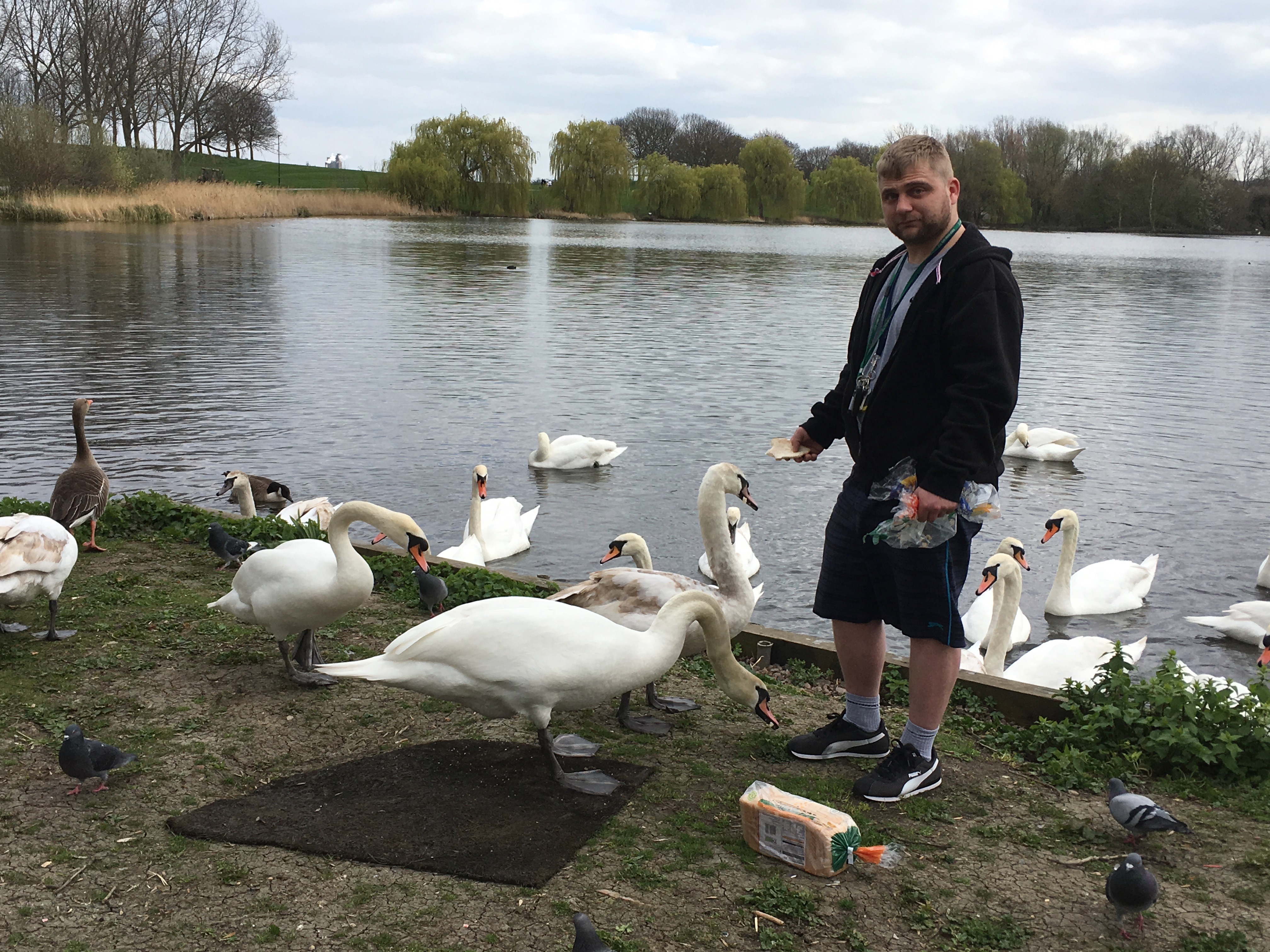
In the morning Uy Hueng from the Ridgeway Group took me on a local walk. He is a worker in public health by day, his hobby is 360 degree camera photos for Google Street View and his charity is the conservation and future use of The Ridgeway (I agreed to talk to their quarterly meeting in June, if the dates can be made to work). I had already viewed his photos without knowing, when I explored the Thames Path on Google Maps to which he regularly contributes.
His main passion is for the protection and development of The Ridgeway. I wasn’t aware that this was another sewage-related landscape feature, designed by Bazalgette to carry the great drainpipes of excrement east. “Not many people know that the temperature of the Ridgeway can be up to 3 degrees warmer than the surrounding land because of the pipe contents, providing unique habitat patterns and a particular Thamesmead ecology” related Uy. So much of the character of this particular bordure, seems related to its ordure.
Like the Victorians themselves, we should not pretend it doesn’t exist, but rather learn how to celebrate it, as a part of our triumph over illness and disease. At the very least according to Uy, the smell from the current treatment works was working as a hedge against the development of the former golf course and other nearby green space.
Uy has lived in Thamesmead for some years and lived for a while in Binsey Walk on the site of the current temporary library. He arrived here as a boat person after the end of the Vietnam War in 1975. The remaining maisonettes are currently surrounded in scaffolding and being demolished. It’s a shame that at least one of the lakeside units is not being preserved. They are original and famous designs and future generations will lament their total loss. At the very least, they would represent a warning to future generations. The following is one of Uy’s photos of the Thames Path in Thamesmead for Google:
https://www.google.it/maps/@51.5093974,0.1061575,3a,75y,270h,90t/data=!3m8!1e1!3m6!1sAF1QipNu02Oj1vZKUl9gP4RMYZTOijK-EklVueu57dJf!2e10!3e11!6shttps:%2F%2Flh5.googleusercontent.com%2Fp%2FAF1QipNu02Oj1vZKUl9gP4RMYZTOijK-EklVueu57dJf%3Dw203-h100-k-no-pi2.2503986-ya219.03429-ro0.23466001-fo100!7i5376!8i2688
THAMESMEAD Friday March 29th 2019
10am
A meeting with Mat Jenner of TACO,(this week Twang, Achoo, Clang, Oooff) a gallery amid the housing of Poplar Place, began the day. It’s a beautiful looking little white cube with a varied programme of work by professional artists who largely draw inspiration from some aspect of the local environment and life. I was surprised that the couple leaving their home just around the corner though, could not tell me where it was. I found a child’s chair abandoned by the side of the road.

Noon
Back at the Diana Café I met artist and curator Sam Skinner, whose practice is focused on relations between technology, media and community and who lives and works in Thamesmead (though his projects take him across the country). I heard more of his innovative community radio station which last year was housed at TACO. After lunch we went for a walk south-west from the town centre toward his allotment on Church Manor Way opposite the local school. I heard a little of his involvement in a food growers group, but pushed for time, I need to return on my next visit to learn more.
I walked back toward Abbey Wood along the Ridgeway again. The hawthorn was all a mass of white blossom. It felt three degrees warmer there.
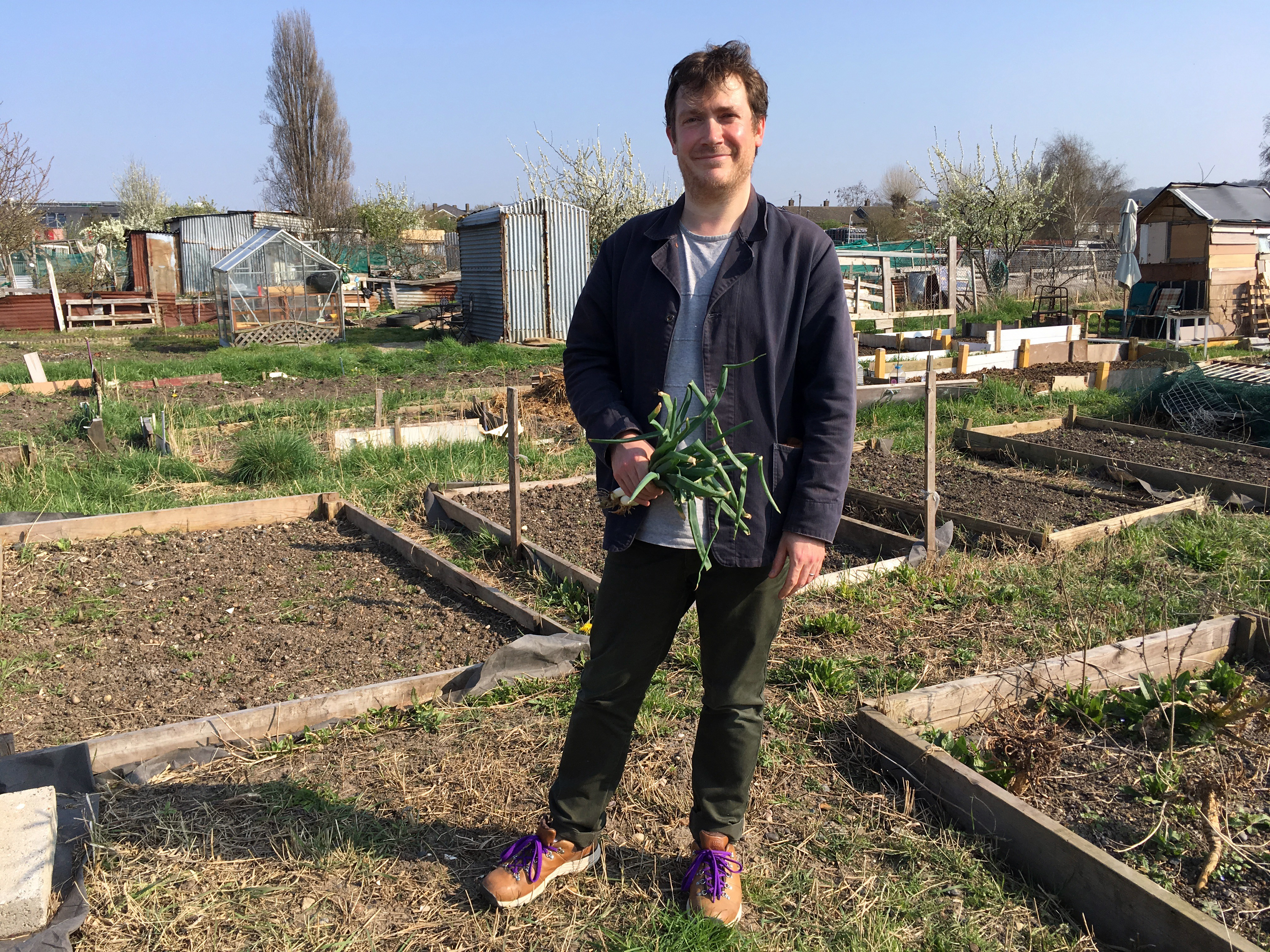
POST SCRIPT
What effect the small intervention the Exbury Egg may have on Southmere Lake, I do not yet know. I like an idea from Chinese acupuncture; that a needle can ease the tension or pressure upon any part of the body – unblock the flow. So with urban acupuncture perhaps the Eggman and others can make their own little ‘pin prick’. That some small action of improvisation and imagination can have unknowable positive consequences. If they are laterally connecting, socially minded and holistic visions, it can’t hurt.
Stephen Turner